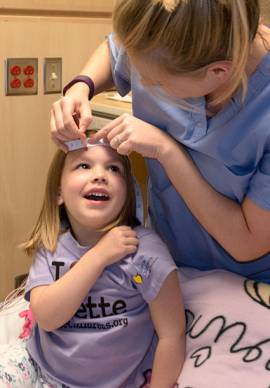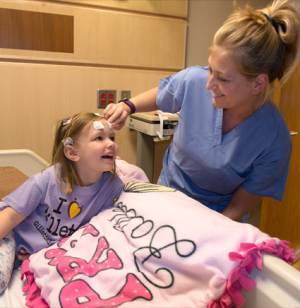-
{care_team_members status="Open|hide from care team page"}
-

{care_team_members:ct_first_name} {care_team_members:ct_last_name}
{care_team_members:ct_full_title}
{/care_team_members}
person:channel_short_name: {person:channel_short_name}
person:
title: {person:title}
-
{links}
{/links}
No category selected to display locations. Locations Dynamic
-
{locations}
- {locations:title} {/locations}
-
{widget}
{widget:widget_content}
- {widget:widget_content:tab_title} {/widget:widget_content} {/widget}
Editor’s note: In celebration of Neurodiagnostics Week, we’re pleased to share a guest article from Sarah Larson, an Electroneurodiagnostic Technologist.
Did you know that the human brain produces electricity? Electrical signals that travel from the brain make our muscles move. When those electrical signals don’t function as they should, it can cause a host of problems including epilepsy, behavioral issues, or nerve and muscle disorders.
Electricity is also the root of neurodiagnostic testing. Through a wide variety of tests, we can measure how well the electricity in the body is flowing. We can identify abnormal electrical discharges in the brain and muscles. We can also tell how fast electricity travels through the spinal cord and nerves—and if there is anything that might be blocking or interfering with the brain’s electrical signals.
Neurodiagnostics Defined
Neurodiagnostics is a term used to describe tests performed for any condition that may be present in the central nervous system (the brain or spinal cord) and the peripheral nervous system. The neurodiagnostic services provided at Gillette include Electroencephalogram (EEG), Video EEG (VEEG), Intraoperative Neurophysiologic Monitoring (NIOM), and Electromyogram/Nerve Conduction Studies (EMG/NCS). Because so many of the patients seen at Gillette have complex conditions impacting their neurological system, offering this advanced level of testing is essential.
How It Works
For routine EEGs, patients come to our lab and meet with one of our technologist. The technologist applies 21 electrodes to the patient’s head using a water-soluble paste. We ask children to follow different commands, observe a light flashing at various speeds, and blow on a pinwheel for several minutes. Then, the patient is able to fall asleep in one of our child-friendly sleeping rooms. Brainwaves are captured while the patient is both awake and asleep.
Longer video EEGs are done in a similar way. Instead of a water soluble paste, we apply the electrodes with glue and give the patient a net-like “hat” to wear and a backpack to carry the electrode box. In most cases the patient will stay overnight in a room equipped with a  camera on the ceiling and an EEG monitor outside the room. This way, if the patient has a seizure overnight, we’re able to look at the brainwaves and simultaneously watch the video. The results help physicians confirm a diagnosis, plan treatments or monitor a patient’s condition.
camera on the ceiling and an EEG monitor outside the room. This way, if the patient has a seizure overnight, we’re able to look at the brainwaves and simultaneously watch the video. The results help physicians confirm a diagnosis, plan treatments or monitor a patient’s condition.
Putting Kids First
Our team’s number one priority is making our patients as comfortable and relaxed as possible during their EEG. There is little to no discomfort during the test, but we understand it can sometimes be scary for patients. We encourage our patients to watch their favorite movies or cartoons and bring their favorite blanket or stuffed animal. We have lots of toys and activities, and an iPad with games for all ages. Parents can stay with their child during the entire EEG process. If needed, we can also utilize Child Life services to interact with patients. For patients who need to stay overnight, Gillette offers evening activities such as crafts and dog shows. We consider it a privilege to interact with the children and families we serve on a daily basis—and through the neurodiagnostic services we provide, to give them the best quality of life possible.
Pictured above: Sarah Larson, a Gillette Electroneurodiagnostic Technologist, and 4-year-old Sophie.



